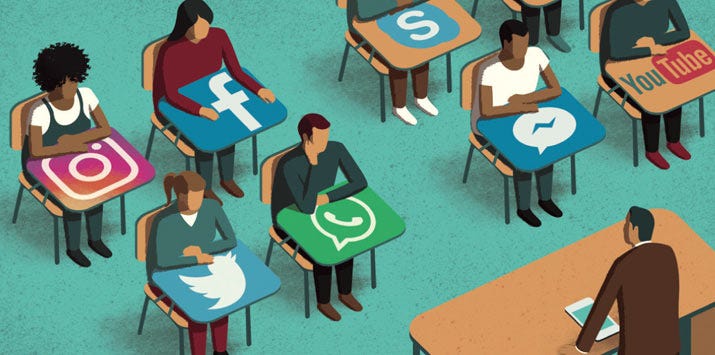Ed Tech Blog

In a world where screens dominate our daily lives, the call of the great outdoors is more alluring than ever. But what if we could combine the wonders of nature with the power of technology to create an educational experience like no other? Welcome to the realm of outdoor education with a digital twist, where students step out of the classroom and into the real world armed with smartphones and tablets, ready to explore, learn, and be inspired.
Why Outdoors?
Outdoor education isn't just about taking students outside; it's about immersing them in an environment rich with real-world examples that transcend the confines of textbooks and classrooms. It's about engaging their senses, stimulating their minds, and fostering a deep connection with the world around them. After all, there's only so much you can learn about a tree or a river from a picture in a book.
One of the key principles of outdoor education is recognizing the unique characteristics of the environment in which it takes place. Whether it's the rugged terrain of the mountains, the lush greenery of the forest, or the vast expanse of the desert, each location offers its own lessons to be learned. From rocks and plants to waterways and wildlife, every element plays a vital role in shaping the landscape and influencing the ecosystems that thrive within it.
But outdoor educators also need to be mindful of the cultural and geographical context in which they operate. Every country, every region, has its own distinct identity shaped by its history, its people, and its environment. By acknowledging and respecting these differences, educators can help students develop a deeper appreciation for the world around them and the interconnectedness of all living things.
Scavenger Hunt
So, how do we harness the power of technology to enhance the outdoor...
Read more: Exploring the Great Outdoors: Merging Education with Technology

Are you looking for something cheap, durable, and specifically made for the classroom? Well, Chromebooks are all the rage in the classroom right now, and there are multiple good reasons for it too. In this post we will go through all the reasons to consider buying Chromebooks for the classroom, reasons to not consider buying Chromebooks for the classrooms, and other alternatives to consider.
The Good
The first reason to consider Chromebooks for the classroom is its cost. You can get a good Chromebook ranging from $250 to $300. Chromebooks also have an excellent battery life for a day filled with learning.
All Chromebooks come with a special operating system known as Chrome OS. It is a light-weight operating system designed by Google that revolves around the internet. It’s light-weighted nature also helps with increasing the battery life of the device.
Chrome OS comes pre-equipped with all common applications that is required by students. Apps like Google Docs, and Google Slides are used by almost all students to write reports and create presentations.
Students can easily log into Google Classroom to create a collaborative environment with other fellow students and their teachers. There are other apps that are available in...
On the 30th of November 2022, a chatbot was released by a company called OpenAI. By January 2023, it became what was then the fastest growing software application by gaining 100 million users. This chatbot caused a hurricane of other competing chatbots that were all trying to do one simple thing, make sense of the world of information found on the internet and every written media on Earth. This chatbot is the Chat Pre-trained Transformer or as it is commonly known, ChatGPT.
In this post, we will go through some of the most imaginative ways in which ChatGPT can be used by teachers and educators alike.
In the Classroom
There are a lot of ways in which you can use ChatGPT in the classroom to enhance the learning experience for students.
You can use ChatGPT to create a teaching assistant for each and every student in the classroom. The teaching assistant could be a sounding board for each student, and it can give constructive criticism when required. ChatGPT can help the students round out their reports or arguments by making sure that their work covers all relevant aspects of the topic. ChatGPT can function as their debate partner, or an...

Are you a teacher, or school management who is looking to use technology to improve the quality of education but don’t know where to start? Then you need to read this post where we describe an incredible framework to do just that. The Intel Skills for Innovation (SFI) Framework is a framework that you can use to integrate technology to your programs and plans for cognitive, technical, and socio-economical skill development. You can use this framework for physical, as well as virtual learning environments.
In this post, we will investigate the path to adopt the SFI framework. The steps involve planning, experiencing, training, and deploying.
Planning
The planning stage of the framework involves anticipating the need for change, preparing for the expected changes, responding to sudden disruptions, and adapting to incremental changes on the education system.
Your students will undergo anywhere from 12-14 years of formal school before tertiary education or entering the workforce, hence, it is very important to keep tabs on the various trends on education for the next decade in the least. For this very reason alone, your education institute needs to understand the future of education.
A future-facing educational system needs to have a future-proof vision...
Read more: Are There Easy Steps to Bring Technology in the Classroom?

In the emerging educational landscape, Educational Technology, or EdTech, is playing a crucial role in revolutionizing special needs education. From bridging accessibility gaps to creating individualized learning experiences, EdTech has emerged as the linchpin of inclusive education. It has the potential to transform the learning experience for learners with varying disabilities, making education far more productive and engaging. Here's an in-depth look at how EdTech is reshaping the landscape of special needs education:
1. Individualized Education Programs (IEP):
The 'one-size-fits-all' approach in education is increasingly becoming redundant. EdTech fosters a shift towards more personalized learning experiences, enabling teachers to create individualized education programs (IEPs) that cater to each student's unique challenges and strengths. Disability-specific digital curriculums, adaptive learning software, and customizable lesson plans ensure that learning experiences are tailored to each student's abilities and learning preferences, thereby facilitating a more effective and engaging learning process.
2. Leveraging Assistive Technologies:
Assistive technology has been pivotal in minimizing barriers for students with dyslexia, visual impairments, speech impediments, or hearing loss. Innovative solutions like screen readers, speech-to-text programs, and text-to-speech software imbue a sense of independence in learning for these students. For instance, a student who struggles with handwriting can harness the power...
Read more: Transforming Special Needs Education: The Remarkable Role of EdTech

The digital age has revolutionized the educational panorama with its bountiful advances, and indubitably, social media is one of its most dynamic contributory factors. With ubiquitous platforms such as Facebook, Instagram, Twitter, and YouTube, the world is no longer confined to physical boundaries but is a global village teeming with information and interaction. Through these platforms, learning experiences and knowledge dissemination have been thrust into a new era characterized by collaboration, interaction, and engagement. This, however, brings in a nuanced challenge; integrating social media in the classroom effectively and wisely to primarily focus on education and to create a secure and empowering digital sphere for students.
To give a detailed understanding, let's navigate through the multiple benefits and strategic ways to employ smart usage of social media in the educational domain.
Expounding the Benefits of Social Media in the Classroom:
1. Connectivity and Collaboration: Social media breaks down the walls of the physical classroom, enabling students and educators to interact seamlessly. This offers a landscape conducive to the sharing of information, ideas, and updates. It encourages collaborative projects and group assignment work, utilizing shared digital spaces like Google Drive, aiding in the development of students' communication and teamwork skills.
2.
Read more: Social Media in the Classroom: An In-Depth Look at Smart Usage
